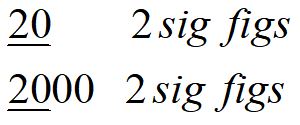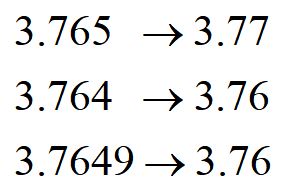Significant figures
The question of how many significant figures (sig figs) to use is really about accuracy. When you say that an object is 2.7 meters long, you are implying that you know its length is between 2.65 and 2.75 meters.
If you know that the length of the object is between 2.65 and 2.75 meters, saying it is 2 meters would be under representing your accuracy. Similarly, saying that it is 2.64 meters is just wrong.
Reporting that the length is 2.7652 may seem like it is a better answer because it contains more information, but it is over representing our accuracy. You do not know its length to the tenth of a millimeter.

Trailing zeros after a decimal point are counted as sig figs, leading zeros after a decimal point are not.

Trailing zeros for an integer number are not counted as significant figures.

The exception to this rule is when there is only one integer. Numbers that contain only one integer are assumed to have 2 significant figures.
There are different rules for retaining significant figures while doing mathematical operations like addition and subtraction or multiplication and division. In this course, we will simplify this approach.
You should use the same number of significant figures in your answer as what is given in the problem statement. If there are differing numbers of significant figures in the given values, use the lowest number of sig figs in your answer.
Rounding
If you have calculated a number that has too many significant figures and need to shorten it, the rule is to raise the last value by one digit if the following value is 5 or more.

For example, 3.765 rounds to 3.77 because the value after the 6 is at least 5. 3.764 does not round up because that value is 4. Also, 3.7649 does not round up because that value is 4.
In solving problems, the best approach is to do a completely symbolic solution and put numbers in as a very last step before calculating your final answer. A completely symbolic solution has the form of a variable that equals an expression that contains only given variables.
If you do arithmetic for intermediate steps in your calculation, keep at least one more sig fig for your values until the very final step, and then shorten to the correct significant figures.
